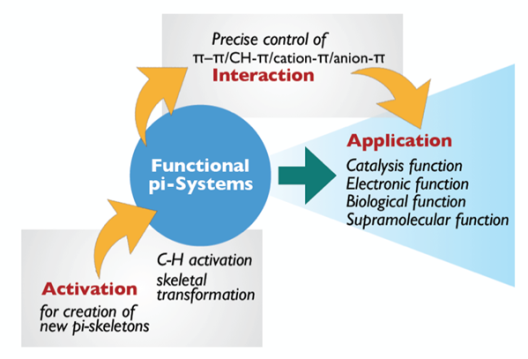Functional π-Systems:
Activation, Interaction and Application

π-Systems are ubiquitous in chemistry and related fields. π-Conjugated skeletons are essential platforms to generate photonic and electronic functions, are important in catalysis, show various biological activities and are also highly important in the design of supramolecular materials. The design and synthesis of new π-conjugated systems that show unusual properties will lead to the development of the next generation materials and also to novel applications. It is therefore essential that synthetic methods for the synthesis, activation and functionalization of π-systems and their use towards the construction of novel materials will be developed. These challenging tasks can be very well addressed by the scientists from Nagoya and Münster participating in this IRTG “pi-Sys”, who are well experienced in these fields. The research line of “pi-Sys” will contain three pillars that are activation of functional π-systems, interaction of functional π-systems and application of functional π-systems. As indicated in Figure 1, the three pillars in “pi-Sys” are linked with each other. For example, methods development on the activation of π-systems will lead to novel compounds that are eventually applied as functional materials such as dyes in bio-imaging studies or as catalysts. The understanding of π-interactions will lead to improved materials properties.
Novel π-systems will allow designing new materials that are applied to construct light-emitting diodes, field-effect transistors and solar cells. Dyes generally comprise π-systems and are indispensable in our daily life. For optimization of materials properties, fine-tuning by late-stage functionalization of π-systems will become increasingly important and “pi-Sys” will develop mild, valuable and broadly applicable synthetic methodology along these lines. Specially designed π-systems find use as fluorophores in photo imaging studies for the elucidation of biological processes. However, currently used dyes often bleach which leads to limitations in their applicability and the IRTG will address that challenge for example, by incorporating heavier main group elements into the π-systems leading to improved materials. Switchable π-systems have become key subunits as control elements in functional soft “smart” materials. To bring such intelligent switchable systems to the next level, long time stability and switching time have to be improved. The combined expertise in “pi-Sys” will offer an excellent platform to address these tasks. In addition to the development of new skeletons, the other crucial issue in this research field is to precisely control interactions with and/or between π-systems. π-π-Interactions have been applied to construct complex aggregates with defined functions. Such interactions are also essential in biological systems where π–π, cation–π, anion–π, and halogen–π interactions control selectivity and activity. The elucidation of such weak interactions will provide in-depth insights into the origin of biological functions, which should eventually lead to the development of new classes of biomaterials or bio-inspired materials. Needless to say, theoretical chemistry plays a crucial role in understanding π-interactions and accordingly will occupy a prominent role in this IRTG.
Considering transition-metal catalysis, π-interactions are crucial in reactivity control as many metal ligands are based on functional π-systems. The development of novel catalyst systems enabling chemical transformations that are not possible to date will lead to industrial technological innovation. To tune catalyst functions, π-interaction between the substrate and catalysts should play a crucial role in achieving high chemoselectivity and more generally activity. Of note, π-interactions as steering elements are not restricted to metal-based catalysis but also play a prominent role in organocatalysis, as addressed by “pi-Sys” where great knowledge in the area of organocatalysis is available.
From these points of view, there is no doubt about the increasing importance to study π-system chemistry in an integrated and interdisciplinary approach, which will allow to further push the boundaries of modern chemical sciences contributing to the sustainable development of our society.

